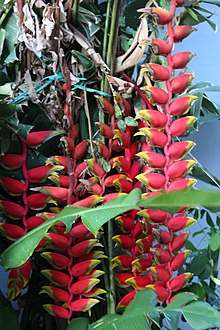Heliconia rostrata
Heliconia rostrata (also known as hanging lobster claw or false bird of paradise) is an herbaceous perennial native to Peru, Bolivia, Colombia, Costa Rica, and Ecuador, and naturalized in Puerto Rico.[2] Other Heliconias grow in the upright position (e.g. Heliconia bihai), their cup-shaped flower bracts storing water for birds and insects. This plant, however, has downward-facing flowers, the flowers thus providing a source of nectar to birds.[3][4]
| Heliconia rostrata | |
|---|---|
 | |
| Lobster claws flower at peak season, Udumalpet,India | |
| Scientific classification | |
| Kingdom: | Plantae |
| Clade: | Tracheophytes |
| Clade: | Angiosperms |
| Clade: | Monocots |
| Clade: | Commelinids |
| Order: | Zingiberales |
| Family: | Heliconiaceae |
| Genus: | Heliconia |
| Species: | H. rostrata |
| Binomial name | |
| Heliconia rostrata Ruiz & Pavon | |
| Synonyms[1] | |
| |
Heliconias are known to those who grow them as a host flower to many birds, especially the hummingbird. Because of its unique characteristics, it is often used as a specimen for tropical gardens.
Along with the Kantuta flower, Heliconia rostrata, known as patujú, is the national flower of Bolivia.
Gallery
 Heliconia rostrata
Heliconia rostrata Heliconia rostrata Inflorescence
Heliconia rostrata Inflorescence Heliconia rostrata Inflorescence close up
Heliconia rostrata Inflorescence close up Heliconia rostrata Inflorescence in West Bengal, India
Heliconia rostrata Inflorescence in West Bengal, India Grown in Malaysia
Grown in Malaysia
References
- The Plant List, Heliconia rostrata
- Kew World Checklist of Selected Plant Families, Heliconia rostrata
- Ruiz López, Hipólito & Pavón, José Antonio. 1802. Flora Peruviana, et Chilensis 3: 71, t. 305, Heliconia rostrata
- Brako, L. & J. L. Zarucchi. (eds.) 1993. Catalogue of the Flowering Plants and Gymnosperms of Peru. Monographs in systematic botany from the Missouri Botanical Garden 45: i–xl, 1–1286.
| Wikimedia Commons has media related to Heliconia rostrata. |